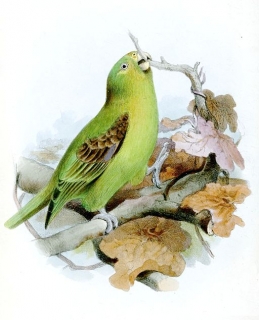Spot-winged Parrotlet |
|
|
Also known as: Brown-shouldered Parrotlet
Photos
View in GalleryDid You Know?
Parrotlets were kept in a French menagerie as long ago as 1682.Academic Research
Related publications: Touit stictopterusSpecies Profile
Genus: Touit | Species: stictopterus
Size:
17cm (6.6 in)
Weight:
71-84g (2.5-3 oz)
Subspecies including nominate:
one
Colour Adult:
Male-green/yellow in general; area around lores and eyes green/yellow; black/brown bend of wing; brown scapulars, lesser wing coverts and inner median wing coverts with white spotting; dull orange on outer two median wing coverts; dark brown secondaries and secondary coverts; green underwing coverts; uppertail green with red /brown margins on inner webs of lateral feathers; undertail olive/yellow. Bill olive/yellow with grey at base. Eye yellow/brown. Female-green upperwing coverts with exposed black bases to feathers; brighter yellow lores and forecheeks; brown primary coverts widely edged with green.
Colour Juvenile:
As in adult female.
Call:
Calls made in flight are harsh and high-pitched, or raspy.
Listen NowMore Information:
Content Sources:
CITES
BirdLife International
Cornell Lab of Ornithology/Birds of the World
Parrots: A Guide to Parrots of the World, Juniper and Parr, 1998
ML Media Collection Catalogue 40205, Spot-winged Parrotlet Touit stictoptera, Schulenberg, Thomas, San Martin, Peru, Jul. 26 1986, Cornell Lab of Ornithology. Site
Parrots of the World, Forshaw, 2006. 2010 edition
Lexicon of Parrots, Thomas Arndt.
Photos
View in GalleryDid You Know?
Parrotlets were kept in a French menagerie as long ago as 1682.Academic Research
Related publications: Touit stictopterusSpecies Care
Captive Status:
Not usually seen in captivity.
Longevity:
Not recorded.
Housing:
House in tall enclosure with many plantings for hiding, minimum temperature 20C (68 F).
Diet:
Fruits such as: apple, pear, banana, orange, cactus fruits, mangos, papaya; berries such as: pyracantha, mountain ash, elder; lory nectar; vegetables such as: carrots, celery, green beans and peas in the pod; green leaves such as: Swiss chard, lettuce, kale, dandelion, chickweed; half-ripened seeds; sprouted millet, canary grass seed, oats, barley and a little sunflower; vitamin and mineral supplements; complete kibble for small parrots if taken.
Enrichment:
Not recorded.
Nest Box Size:
Not recorded.
Clutch Size:
Not recorded.
Incubation Time:
Not recorded.
Fledging Age:
Not recorded.
Hatch Weight:
Not recorded.
Peak Weight:
Not recorded.
Weaning Weight:
Not recorded.
Photos
View in GalleryDid You Know?
Parrotlets were kept in a French menagerie as long ago as 1682.Academic Research
Related publications: Touit stictopterusSpecies Wild Status
World Population:
1000-2500, decreasing.
IUCN Red List Status:
Near Threatened
CITES Listing:
Appendix II
Threat Summary:
Uncommon although probably unrecorded due to shy nature. This species is rare and declining due to continuing deforestation and fragmentation for illegal crops and human settlement, particularly in Colombia. Exploration of suitable habitat in E Ecuador and NE Peru needed to clarify status.
Range:
C Colombia, on western slopes of Cordillera Central in Cauca, western slopes of Cordillera Oriental in Cundinamarca, Sierra de la Macarena in Meta and possibly E Narino and eastern slopes of Andes in E Ecuador to N Peru.
Habitat:
Found from 350-2300m (1148-7544 ft) in tall humid subtropical forest; also reports from savanna-like woodland and stunted ridge-top growth.
Wild Diet:
Feeds on fruit and seeds, including mistletoe; may feed on maize crops and sometimes in Ficus and Clusia trees. Recorded feeding on termites in Colombia.
Ecology and Behaviour:
Little known; it is thought that this species moves in response to food availability. Usually seen in groups of up to 10 individuals, with larger flocks where food abundant. Is quiet and easily overlooked while resting or feeding in dense foliage.
Clutch and Egg Size:
Not recorded.
Breeding Season:
Possibly March, Ecuador.
Related Links:
Photos
View in GalleryDid You Know?
Parrotlets were kept in a French menagerie as long ago as 1682.Academic Research
Related publications: Touit stictopterusMembers Only Resources
Please log-in now to find more research, resources and tools.
Not a Member?
Find more great information:
Gain exclusive access to 600+ pages of additional research, seminars and podcasts, specialists to ask your toughest questions, and dozens of other fun resources - when you become a WPT member.
Join Today >>

































